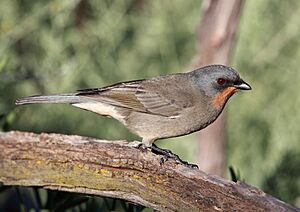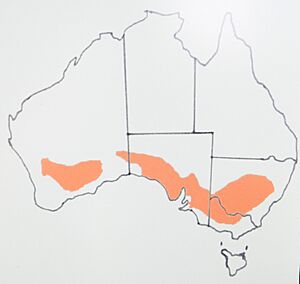Gilbert's whistler facts for kids
Quick facts for kids Gilbert's whistler |
|
|---|---|
 |
|
| Conservation status | |
| Scientific classification | |
| Genus: |
Pachycephala
|
| Species: |
inornata
|
The Gilbert's whistler (Pachycephala inornata) is a special type of bird found only in Australia. It lives in dry, semi-arid areas across southern Australia. This bird is known for its beautiful, loud songs.
Contents
About the Gilbert's Whistler
The Gilbert's whistler belongs to a bird family called Pachycephalidae. This family started in the Australia and Papua New Guinea region. The Gilbert's whistler is a very old type of bird in its group, meaning its family line has been around for a long time. Scientists believe it was once found in more places.
John Gould, a famous bird expert, first described this bird in 1841. He named it after Mr. Gilbert, who found the bird in Western Australia. Mr. Gilbert collected some birds and gave them to Gould.
The scientific name, Pachycephala inornata, has a cool meaning. Pachycephala comes from ancient Greek words meaning 'thick' and 'head'. Many birds in this group are called 'thickheads'. The second part, inornata, means 'plain' in Latin. This refers to the Gilbert's whistler's feathers, which are often described as plain or simple.
What Gilbert's Whistlers Look Like
Adult male Gilbert's whistlers weigh about 30 grams. After three years old, they get a reddish-brown chin and throat. This is similar to their close relative, the red-lored whistler. You can tell them apart by the color around their eyes: Gilbert's whistlers have black patches, while red-lored whistlers have red ones.
Female Gilbert's whistlers weigh a bit less, around 23 to 32 grams. They have a light gray throat and a white ring around their eyes. Their belly feathers might have light stripes. Both males and females are brownish-gray all over. They have red eyes and a short, black beak.
Young Gilbert's whistlers are darker than adults and have brown hints. They also have dark stripes on their chest and belly. Very young birds look like adult females but have a brown beak and dark brown eyes. It can be tricky to tell female Gilbert's whistlers apart from female golden or western whistlers where they live in the same areas.
Scientists have studied how the size of Gilbert's whistlers might change. They found that birds living in colder places (higher latitudes) tend to be a bit bigger. This follows a rule in nature called Bergmann's rule.
Life and Habits
Diet
Gilbert's whistlers mostly find their food on the ground. They also look for food in the lower parts of shrubs and trees. Their main food is small invertebrates like insects. They also sometimes eat fruit and seeds.
Nesting and Reproduction
Gilbert's whistlers build a deep, cup-shaped nest inside thick bushes. Sometimes, they even build their nests on top of old nests made by other birds called babblers. Both the male and female birds help build the nest.
The female usually lays two or three eggs, but sometimes four. Both parents take turns sitting on the eggs for about 15 days until they hatch. After the chicks hatch, both parents also help feed and care for them. The young birds are born helpless and stay in the nest until they are ready to fly.
Calls and Songs
Whistlers are known for their beautiful songs, and the Gilbert's whistler is no exception. People often hear this bird more than they see it. Its loud, clear, and lovely calls can be heard from far away, sometimes up to 900 meters! They sing most often during the breeding season to mark their territory.
Their song sounds like a series of growing cheop, cheop, cheop sounds, repeated many times. They also have a rising call that sounds like er-WHIT, er-WHIT, er-WHIT, similar to the rufous whistler. Another call they make is a scratchy sound like eechowk, eechOWK, eeCHOWK.
Where They Live and What They Face
Gilbert's whistlers live in dry, semi-arid areas. They like tall mallee trees with few shrubs underneath, or thickets of Acacia and Casuarina trees. They can also be found in Melaleuca thickets and sometimes in taller eucalyptus forests.
Studies show that Gilbert's whistlers prefer areas that have had bushfires about 30 to 60 years ago. They don't do as well in places that burn very often or haven't burned for more than 60 years.
These birds are found in scattered groups across southern Western Australia, South Australia, northwest Victoria, and central west New South Wales. They usually stay in one place and don't travel far. This means they are very sensitive to changes in their home. If their habitat is disturbed, it can be very hard for them to survive.
For example, in one area of New South Wales, the Gilbert's whistler population disappeared during a long drought in the early 2000s. This was a sad example of 'Extinction Debt', where a species slowly disappears after its habitat is damaged. The main reasons for this were:
- Habitat loss: Land was cleared for farming over the last 100 years.
- Introduced animals: New animals brought by humans, like predators, caused problems.
- Competition: Other native birds started competing for food and space.
- Droughts: Long dry periods, made worse by climate change, made it hard to find water and food.
Protecting Gilbert's Whistlers
The Gilbert's whistler is listed as 'vulnerable' only in New South Wales. This means its numbers and where it lives have decreased there. However, at an international level, it is listed as 'least concern', meaning it is not currently in danger globally.
To help protect these birds, a plan was made in 2015. Some of the important actions include:
- Restoring native plants: Planting back the original trees and shrubs.
- Removing weeds: Getting rid of plants that don't belong and can harm the habitat.
- Controlling noisy miners: Sometimes, these birds can harm other species, so their numbers might need to be managed.
- Smart grazing: Encouraging farmers to let their animals graze in ways that don't harm the bird's habitat.
- Controlled burning: Using small, controlled fires to manage the land, making sure some areas are left unburnt for a long time.
- Raising awareness: Teaching people about the importance of old, large trees for birds.
- Improving soil: Finding ways to make the soil healthier for plants.
Images for kids








